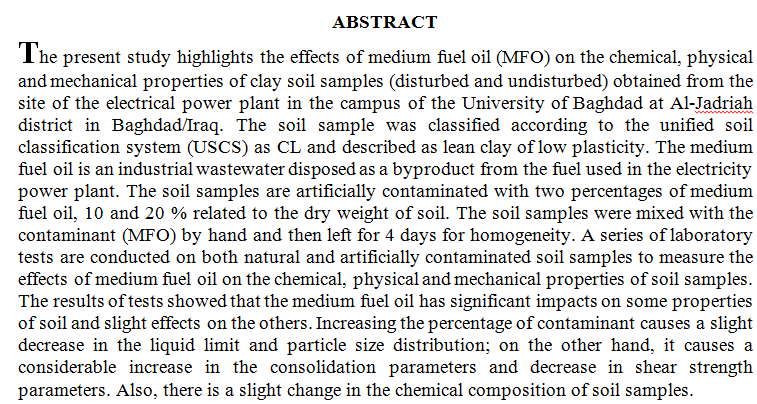
Abstract
Semiconductor-based gas sensors were prepared, that use n-type tin oxide (SnO2) and tin oxide: zinc oxide composite (SnO2)1-x(ZnO)x at different x ratios using pulse laser deposition at room temperature. The prepared thin films were examined to reach the optimum conditions for gas sensing applications, namely X-ray diffraction, Hall effect measurements, and direct current conductivity. It was found that the optimum crystallinity and maximum electron density, corresponding to the minimum charge carrier mobility, appeared at 10% ZnO ratio. This ratio appeared has the optimum NO2 gas sensitivity for 5% gas concentration at 300 °C working temperat
... Show More (3)
(3)
This work investigates the impacts of eccentric-inclined load on ring footing performance resting on treated and untreated weak sandy soil, and due to the reduction in the footing carrying capacity due to the combinations of eccentrically-inclined load, the geogrid was used as reinforcement material. Ring radius ratio and reinforcement depth ratio parameters were investigated. Test outcomes showed that the carrying capacity of the footing decreases with the increment in the eccentric-inclined load and footing radius ratio. Furthermore, footing tilt and horizontal displacement increase with increasing the eccentricity and inclination angle, respectively. At the same time, the increment in the horizontal displacement due t
... Show More (3)
(3)
 (2)
(2)
The aim of the present investigation was to develop a microsponge delivery system of acyclovir to control its release when applied topically thereby reducing dosing frequency and enhancement patient compliance. The microsponges were produced by the oil in oil emulsion solvent diffusion method. The effect of different formulation and process variables such as internal phase volume, polymer type, drug-polymer ratio, stirring speed and stirring duration on microsponge production yield, loading efficiency, particle size and in-vitro drug release was evaluated. The result showed that the microsponge F2 prepared from Eudrajet RS polymer had optimum physical properties regarding the loading efficiency of 99.71_+ 0.7% and product
... Show More (5)
(5)
NiO0.99Cu0.01 films have been deposited using thermal evaporation
technique on glass substrates under vacuum 10-5mbar. The thickness
of the films was 220nm. The as -deposited films were annealed to
different annealing temperatures (373, 423, and 473) K under
vacuum 10-3mbar for 1 h. The structural properties of the films were
examined using X-ray diffraction (XRD). The results show that no
clear diffraction peaks in the range 2θ= (20-50)o for the as deposited
films. On the other hand, by annealing the films to 423K in vacuum
for 1 h, a weak reflection peak attributable to cubic NiO was
detected. On heating the films at 473K for 1 h, this peak was
observed to be stronger. The most intense peak is at 2θ = 37
 (1)
(1)
57 isolates of Mycobacterium tuberculosis and Mycobacterium bovis were identified; they were isolated from different clinical sources which included sputum, bronchial wash, abscess, pleural fluid, gastric fluid, eye fluid, and CSF, also urine and ear swab. This investigation was carried out on 198 patient attended National Reference Laboratory for T.B during September 2009. Also the study declared that the ratio of separation of this bacterium from male was (67.6%) and it’s higher than the ratio of separation this bacterium from females which was (32.3%). The susceptibility of Mycobacterium tuberculosis to melatonin was evaluated. Many concentrati
... Show MoreIn this paper, ceramic water filters were produced by using ten mixtures of different ratios of red clay and sawdust under different production conditions. The physical properties of these filters were tested. The production conditions include five press pressures ranged from 10 to 50MPa and a firing schedule having three different final temperatures of 1000, 1070, and 1100˚C. The tests results of the physical properties were used to obtain best compatibility between the hydraulic and the mechanical properties of these filters. Results showed that as the press pressure and the firing temperature are increased, the bulk density and the compressive and bending strengths of the produced filters are increased, while, the porosity and absorp
... Show MoreIn this work, pure and copper mixed oxide PAni nanofiber thin films are successfully synthesized on silicon substrates by hydrothermal method and spin coating technique at room temperature with thickness of about 325 nm. The structural, surface morphological, optical and photoconductivity properties have been investigated. The XRD results showed that PAni films have crystalline nature, CuO and PAni/CuO nanostructure composites are monoclinic polycrystalline structure. The FESEM images of PAni clearly indicate that it has nanofiber-like structure, whereas the CuO film has spongelike shape. The surface morphology analysis of PAni/CuO composite shows that nanofiber caped with inorganic material which is CuO is a core-shell structure. Op
... Show More (17)
(17)
In this study we examine variations in the structure of perovskite compounds of LaBa2Cu2O9, LaBa2CaCu3O12 and LaBa2Ca2Cu5O15 synthesized using the solid state reaction method. The samples’ compositions were assessed using X-ray fluorescence (XRF) analysis. The La: Ba: Ca: Cu ratios for samples LaBa2Cu2O9, LaBa2CaCu3O12 and LaBa2Ca2Cu5O15 were found by XRF analysis to be around 1:2:0:2, 1:2:1:3, and 1:2:2:5, respectively. The samples’ well-known structures were then analyzed using X-ray diffraction. The three samples largely consist of phases 1202, 1213, and 1225, with a trace quantity of an unknown secondary phase, based on the intensities and locations of the diffraction peaks. According to the measured parameters a, b, and c, every sa
... Show More (2)
(2)
 (1)
(1)
Hot mix recycling of asphalt pavements is increasingly being used as one of the major rehabilitation methods by various highway agencies. Besides general savings in costs and energy expended, it also saves our natural resources and environment. Recycling process presents a sustainable pavement by using the old materials that could be reclaimed from the pavement; these materials could be mixed with recycling agents to produce recycled mixtures. The important expected benefits of recycling process are the conservation of natural resources and reduction of environmental impact. The primary objectives of this work are evaluating the Tensile and Shear Properties of recycled asphalt concrete mixtures, In addition to the
... Show More